Chinese passport
| People's Republic of China passport 中华人民共和国护照 | |
|---|---|
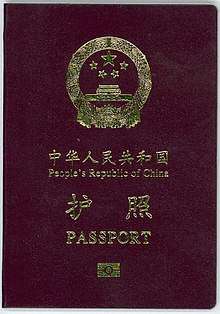 The front cover of an ordinary Chinese biometric passport since 2012 | |
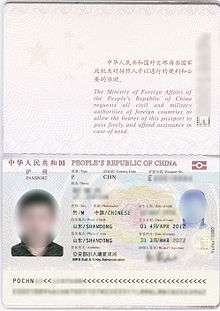 Front personal-information data page of an ordinary Chinese biometric passport since 2012 | |
| Date first issued | 1949 |
| Issued by |
|
| Type of document | Passport |
| Purpose | Identification |
| Eligibility requirements | Chinese nationals with Hukou residing in Mainland China, or Chinese nationals residing abroad who do not qualify for travel documents issued by Hong Kong SAR or Macau SAR.[1] |
| Expiration | 10 years after acquisition for adults aged 16 or over, 5 for children |
| Cost |
¥160 for first passport ¥180 for renewed passport |
The People's Republic of China passport (Chinese: 中华人民共和国护照; pinyin: Zhōnghuá Rénmín Gònghéguó hùzhào), commonly referred to as the Chinese passport, is the passport issued to nationals of the People's Republic of China (PRC) who have registered as a resident of Mainland China hence hold a hukou, for the purpose of the international travel and entitles the bearer to the protection of China's consular officials overseas.
In 2014, China issued 16 million passports, ranking first in the world, surpassing the United States (14 million) and India (10 million).[2] As of 2012, over 38 million Chinese nationals hold ordinary passports, comprising only 2.86% of the total population at the time.[3] The number of ordinary passports in circulation raised to 120 million as of October 2016, which was approximately 8.7% of the population.[4]
On 30 January 2011, the Ministry of Foreign Affairs of the People's Republic of China launched a trial issuance of e-passports for public affairs. The face, fingerprint and other biometric features of the passport holder will be digitalized and stored in pre-installed contactless smart chip in the passport.[5][6] On 1 July 2011, the Ministry began issuing biometric passports to all individuals conducting public affairs work overseas on behalf of the Chinese government.[7] Ordinary biometric passports have been introduced by the Ministry of Public Security starting from 15 May 2012.[8] As of April 2017, China had issued over 100 million biometric ordinary passports.[9]
Overview and Contents
Types
Articles 3, 4, 5 and 8 of the Passport Law of the People's Republic of China, which went into effect in 2007, declares three types of passports issued in Mainland China:[10]
- Ordinary passports (普通护照) are issued to nationals who intend to go abroad for non-official purposes, such as taking up residence in other countries, visiting relatives, studying, working, travelling or engaging in business activities. They are issued by the Exit and Entry Administration (EEA) of the Ministry of Public Security (MPS) or by the EEAs at the county or city level which are authorized by the MPS, or the foreign missions of the People’s Republic of China, or other missions overseas authorized by the Ministry of Foreign Affairs.
- Diplomatic passports (外交护照) are issued to diplomats, consuls and their spouses or children who are minor, as well as to diplomatic couriers. They are issued by the Ministry of Foreign Affairs (MFA).
- Service passports (公务护照) are issued to employees who are dispatched by the Chinese government to work for Chinese foreign missions, the United Nations or its special commissions, or other international organizations, as well as their spouses or minor children. They are issued by the MFA, foreign missions of the People’s Republic of China, other missions overseas authorized by the MFA, or the Foreign Affairs Offices under the governments of provinces, autonomous regions, municipalities directly under the Central Government and cities divided into districts authorized by the MFA.
- A special variation of the service passport, called the passport for public affairs (公务普通护照, lit. ordinary service passport), is issued to public servants who "lead divisions or equivalents" of county or state-owned companies, and employees of state-controlled companies.[11]
Article 9 of the Law states that the "issuing scope of diplomatic passports and service passports, the measures for issue of such passports, their terms of validity and the specific categories of service passports shall be prescribed by the Ministry of Foreign Affairs".
The ordinary passport is considered a passport "for private affairs" (因私护照), while service (including for public affairs passports) and diplomatic passports are passports "for public affairs" (因公护照).[12]
The passports for Macau and Hong Kong SARs are issued and regulated by the governments of these regions, and are therefore not covered by this law.
In July 2011 the Chinese government began to issue biometric diplomatic passports, service passports and passports for public affairs.[11] The launch date of biometric ordinary passports was May 15, 2012.
.png) Diplomatic e-passport
Diplomatic e-passport.png) Service e-passport
Service e-passport.png) Public Affairs e-passport
Public Affairs e-passport Ordinary e-passport
Ordinary e-passport
Passport for public affairs
A different passport for public affairs (因公普通护照, lit. ordinary passport for public affairs) was issued until 2006. Unlike the current version, it was classified as a variation of ordinary passport. The abuse of the use of document resulted in its subsequent cancellation. Unlike other passports, it was issued by the provincial or municipal Foreign Affairs Offices, rather than the Ministry of Foreign Affairs or the Ministry of Public Security.[13]
In 1996, 77% of persons exiting China held a passport for public affairs.[14] The rate had dropped to 39% by 2002.[15] The reason for the high rate of usage was because the passport for public affairs offered more visa-free countries, such as Russia, than the ordinary passport.[13] Chinese regulations require public affairs passports to be kept in the possession of the holder's work unit,[16] and they must be surrendered by the individual within one month of returning to China.[17]
Validity
The passport previously had an across-the-board 5-year period of validity. Since 2007, ordinary passports are valid for 10 years for bearers above 16 years of age, and for 5 years for bearers below 16 years of age, and diplomatic or service passports are valid for 4 years. According to the 2006 Passport Law of the People's Republic of China, renewal of previously issued passports ended on January 1, 2007. However, passports renewed before 2007 remained valid until expiry.
Format
The newest version of the regular Chinese passport is the biometric version, which replaced its predecessors "Form 92", "Form 97-1" and "Form 97-2". It was released to the general public in May 2012. The passport contains 48 pages.
Ordinary Passport - Inside
Form "97-2"
.jpg)
The Form "97-2" ordinary Chinese passport is a machine-readable passport. In "97-2", personal data is on the inside front cover along with a coloured photo printed with inkjet printer, with a protection film covering most of the data page. Details include:
- Passport code (P)
- Country Code (CHN)
- Passport number (G########) - consists of one letter indicating passport type (G = ordinary), followed by eight digits
- Surname
- Given Names
- Sex (M/F)
- Date of birth (DD.MMM.YYYY)
- Date of issue (DD.MMM.YYYY)
- Place of birth (Province, or city/province/state if born abroad)
- Place of issue (Province, or city/province/state of diplomatic/consular authority if issued abroad)
- Date of expiry (DD.MMM.YYYY)
- Authority (Exit & Entry Administration, Ministry of Public Security or the Chinese diplomatic and consular mission)
- Machine Readable Code
Biometric passport

In the biometric Passport, the personal data page was moved to a separate sheet of paper, and the design of personal data page has been amended significantly, adding the full name of PRC in Simplified Chinese and English on top along with an e-passport symbol printed with optically variable ink. New security features include a second ghost image of the holder and additional holographic graphs including the PRC emblem and the laser-printed world map. The details included are as follows:
- Passport code (P)
- Country Code (CHN)
- Passport number (E########) - consists of one letter indicating passport type (E = e-passport), followed by eight digits. As of April 2017, over 100 million ordinary biometric passports had been issued and old E+8 digits type passport numbers had been used up. So the number format has been extended by using the second digit and replacing it with the English letters in order (except I, O) the third digit is still Arabic numerals, and the total number of digits is still 9. New passport numbers started with EA0000001 (two letters with seven digits).[9]
- Name (Chinese characters on top, Pinyin transcription on bottom, a comma separates surname and given names in Pinyin only)
- Sex (M/F)
- Nationality (Chinese)
- Date of birth (DD.MMM.YYYY)
- Place of birth (Province with romanized transcription, or the country code if born abroad, along with Chinese abbreviation of the country)
- Date of issue (DD.MMM.YYYY, month is transcribed into Arabic numerals)
- Place of issue (Province, or city of diplomatic/consular authority if issued abroad)
- Date of expiry (DD.MMM.YYYY, month is transcribed into Arabic numerals)
- Authority ("MPS Exit and Entry Administration" or the full name of the Chinese diplomatic/consular authority)
- Bearer's signature
- Machine Readable Code
Languages
All information is printed in Simplified Chinese and English, except for the "Attentions" page, which is only printed in Simplified Chinese.
Passport Note

- In Chinese
中华人民共和国外交部请各国军政机关对持照人予以通行的便利和必要的协助。
- In English
The Ministry of Foreign Affairs of the People's Republic of China requests all civil and military authorities of foreign countries to allow the bearer of this passport to pass freely and afford assistance in case of need.
- In French (On version 82 only)
Le Ministère des Affaires étrangères de la République populaire de Chine prie les autorités civiles et militaires des pays étrangers de laisser passer librement le titulaire de ce passeport et de lui prêter aide et assistance en cas de besoin.
On version "97-1" and "97-2", it is on page 1. On the biometric version, it is moved to page 3.
Inner pages

.jpg)
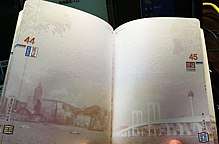

In the biometric version, selected nature hotspots and famous sights of mainland China, Hong Kong, Macau and Taiwan are printed in the inner pages, each page also contains a transparent watermark of another nature hotspots and famous sights in the same area.
Last page
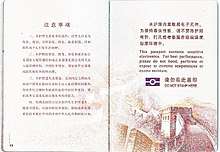
The last page has the notes for the passport. For e-passport, inside the backcover, a caution for the biometric chip is written in both Chinese and English:
本护照内置敏感电子元件。为保持最佳性能,请不要将护照折弯、打孔或者暴露在极端温湿度环境中。
This passport contains sensitive electronics. For best performance, please do not bend, perforate or expose to extreme temperatures or excess moisture.![]()
Fee and processing time
The fee for a Chinese passport is CNY 160. When applying for a passport overseas, the fee is US$25 or €20. No extra fees are charged for expedited processing if approved.[18]
Normal processing time is 10 business days when applying from Mainland China, and 15 business days from Chinese diplomatic missions outside Mainland China (including Hong Kong and Macau). In some Regions, processing time is 7 business days such as Shanghai City if application was submitted electronically (online or by cell phone APPs such as Wechat).[19] Expedited processing is available for 5 business days, but is only available if the applicants have genuine emergencies, such as they have deceased relatives abroad, their first day of school is near, or they have unused visas in old passports that are expiring soon.[20] Some regions, such as Xinjiang, have stricter rules regarding the application process which requires additional background checks and an invitation letter from a friend or family outside Mainland China, or a travel voucher from a tourist agency. In this case, processing time is usually more than 30 business days and could be prolonged.[21]
Special administrative region passports
Chinese nationals who are also permanent residents of Hong Kong or Macau Special Administrative Regions of the PRC are issued Hong Kong or Macau SAR passports by the respective immigration departments of the SARs. In Hong Kong, Hong Kong Immigration Department takes charge of issuing passports. In Macau, Identification Services Bureau does the same role. The SAR passports and travel documents are issued solely by the government of the SARs, and the designs differ greatly from that of the regular PRC passport, albeit all three passports bear the same country and nationality code, CHN, meaning that the bearer holds the People's Republic of China nationality, as well as the message from Ministry of Foreign Affairs of the PRC.
Some countries classify Chinese nationals with SAR passports as Hong Kong citizens or Macau citizens for visa issuing purpose, other than the ordinary Chinese citizens classifications. Holders of SAR passports enjoy visa-free entry to many more countries than holders of regular PRC passports due to their highly developed social and economical status.
While the SAR passports and travel documents are endorsed by China, mainland ports of entry controlled by the Ministry of Public Security do not accept those documents for journeying between the mainland and the SARs. MPS requires SAR residents of Chinese nationality to use a Home Return Permit. Also, SAR passports are not required when travelling between two SARs, but residents should bring their permanent residence IDs.
Chinese nationals who are not permanent residents of Hong Kong are issued Hong Kong Document of Identity for Visa Purposes, and of Macau Macao Special Administrative Region Travel Permit or Visit Permit for Resident of Macao to HKSAR.
Non-passport travel documents
The following travel documents are also issued by mainland China to Chinese nationals who may or may not qualify for a Chinese passport for various reasons:
Chinese Travel Document
- Chinese nationals (i.e. any person who qualifies for Chinese (People's Republic of China, PRC) nationality under the Chinese Nationality Law which includes most nationals of Taiwan or ROC) abroad who do not qualify for a PRC passport can be issued a Chinese Travel Document from PRC Embassies and Consulates outside Mainland China, including:
- Children born to Chinese parents abroad who derive Chinese nationality from their parents through jus sanguinis;
- ROC nationals residing abroad, including nationals without household registration, wishing to visit Mainland China or Hong Kong and do not have a Taiwan Compatriot Permit;
- Journeys to Hong Kong require a separate application for Hong Kong Entry Permit, affixed on the Chinese Travel Document.
- Residents of Special administrative regions of China wishing to visit Mainland China and do not have a Home Return Permit;
- Chinese nationals who have lost their Chinese passports, HKSAR passports or MSAR passports while abroad.
Exit-Entry Permit for Travelling to and from Hong Kong and Macau
The Exit-Entry Permit for Travelling to and from Hong Kong and Macau, also known as the Two-way Permit, is issued to Chinese nationals with hukou who only wish to visit Hong Kong and Macau.
Permit for Proceeding to Hong Kong and Macao
The Permit for Proceeding to Hong Kong and Macao, also known as the One-way Permit, is issued to Chinese nationals who are settling in Hong Kong or Macau and have relinquished their Chinese residency (hukou). After their initial entry to Hong Kong or Macau, they are considered as SAR residents and are permanently ineligible for an ordinary Chinese passport, and later they will be eligible for SAR passports if they acquire a permanent resident status in the respective SARs.
Travel Permit to and from Taiwan
The Travel Permit to and from Taiwan, colloquially known as Mainland Compatriot Permit or Mainland Resident Travel Permit, is issued to Chinese nationals with hukou in Mainland China by Ministry of Public Security, to those who wish to travel directly between Mainland China and Taiwan. Holders of the permit are required to obtain exit endorsements issued by MPS and Exit and Entry Permit issued by Taiwanese authorities prior to travelling.
Self-Service Immigration System (e-Channel)
Holders of Chinese biometric Passports are eligible to use the Self-Service Immigration System, or e-Channel. E-Channel are located throughout numerous international airports in Mainland China (including the four busiest international gateways: Beijing Capital International Airport, Shanghai Pudong International Airport, Shanghai Hongqiao International Airport and Guangzhou Baiyun International Airport) as well as land border crossing checkpoints in Shenzhen and Zhuhai. e-Channel was first introduced for self-entry, i.e. for Chinese biometric passport holders return to China from Outside destinations. In order to use the e-Channel, they must hold biometric passports with their fingerprint data pre-recorded on the biometric chip. If their biometric passports do not contain fingerprint data, they must first register with China Immigration Inspection (CII) at land border checkpoints or international airports to be eligible.[22]
Starting from August 19, 2016, passengers are able to use the e-Gates in terminal 2 of Beijing Capital International Airport to complete exit procedures from China as well.[23]
Starting from Dec 1, 2017, Shanghai international airports including PVG and SHA both have e-Channel for exit.[24]
Eligibility
The extended list of eligible travellers is:[25][23]
Registration with CII not required:
- Holders of biometric passports that contain fingerprint data;
- Holders of the new biometric Two-way Permits with valid entry endorsements that contain fingerprint data.
Registration with CII required:
- Holders of the booklet-style Two-way Permits with multiple-entry endorsements;
- Holders of Travel Permit to and from Taiwan for Mainland Residents booklet with multiple-exit endorsements;
- Holders of Exit and Entry Permits that are valid for one year and multiple entries (only for the specific port of entry that they have registered with);
- Holders of Home Return Permits;
- Holders of Taiwan Compatriot Permits;
- Foreign nationals with their passports and Chinese Permanent Resident cards;
- Foreign nationals with their biometric passports and residence permits with a validity of more than 6 months; and
- Flight crew members serving scheduled flights who are either Chinese or visa-exempt nationals, or non-visa-exempt nationals holding crew or work visas or residence permits that are valid for at least 1 year.
Visa requirements

Visa requirements for Chinese citizens are administrative entry restrictions by the authorities of other states placed on citizens of the People's Republic of China. According to the 1 January 2018 Henley visa restrictions index, holders of a Chinese passport are granted visa free or visa on arrival access to 70 countries and territories, ranking the Chinese passport 68th in the world [26][27] Before February 2014, Chinese immigration authorities did not generally allow mainland Chinese citizens to board outbound flights without a valid visa for the destination country, even if the destination country granted a visa on arrival to Chinese passport holders, unless the exit was approved by the Ministry of Public Security. Exceptions were possible if the traveller had a third country's visa and a connecting flight from the destination country to the third country.[28][29]
Travel to and from Hong Kong, Macau, or Taiwan
Issued to Chinese nationals with Hukou or Chinese nationals not qualified for SAR-issued travel documents, Chinese passports cannot normally be used when travelling directly to Hong Kong, Macau, or Taiwan from Mainland China.
In order for such Chinese nationals to travel from Mainland China to Hong Kong and Macau, a Two-way Permit is required. Chinese foreign missions, however, do issue visa-like Hong Kong SAR Entry Permits to Chinese nationals residing outside Mainland China upon request, so PRC passport holders can travel solely between Hong Kong and Mainland with passports. Chinese passports can be used when transiting through Hong Kong or Macau to other countries and can enter Hong Kong or Macau for 7 days without a visa.
Travelling to Taiwan from Mainland China requires the Travel Permit to and from Taiwan as well as Exit and Entry Permit issued by the Taiwanese government. Although Chinese passports are accepted as valid travel documents by the National Immigration Agency (NIA) and Taiwanese diplomatic missions,[30] the MPS does not allow Chinese nationals with hukou to travel to Taiwan when departing from Mainland China unless holding the Mainland Resident Travel Permit with valid exit endorsement.
Foreign travel statistics
These are the numbers of Chinese visitors to various countries:
- 1 2 3 4 5 6 7 8 9 10 11 12 Counting only guests in tourist accommodation establishments.
- 1 2 Data for arrivals by air only.
- 1 2 3 Including Hong Kong.
- ↑ Including Hong Kong and Macau.
- ↑ Data for arrivals by air only.
- ↑ Total number includes tourists, business people, students, exchange visitors, temporary workers and families, diplomats and other representatives and all other classes of non-immigrant admissions (I-94).
Consular protections to Chinese passport holders (including Hong Kong, Macau & Taiwan residents)
In Chinese, passport is huzhao, meaning "protection document". Consular service is provided by the Chinese government to Chinese passport holders (including HK and MC SAR) and Taiwan residents. Recent consular protection activities include:
Due to a volcano eruption on Bali island, Indonesia in Nov 2017, over 17,000 Chinese citizens couldn't return to China on time. When the Bali airport opened temporarily on Nov 29th 2017, the Chinese government organized chartered flights with two state owned airlines: China Southern Airlines and China Eastern Airlines. China Southern Airlines provided two Airbus A320s and China Eastern Airlines provided six Airbus 333 as charted flights to carry Chinese tourists back.[157] Until Nov 30th, 2017, 18 government charted flights had been provided and over 3,700 Chinese citizens had been carried back to China.[158] As of 18:00 pm of Dec 2, 2017, 13,514 Chinese nationals had been carried back by Chinese government charted flights (operating airlines including Chinese state owned airlines: China Eastern airlines, China Southern Airlines and Xiamen airlines as well as some foreign airlines). The evacuation is free and done in this order: mother with child, females, the elderly and men.[159]
Due to Hurricane Maria hitting the Caribbean area in September 2017, over 400 Chinese citizens were stranded. On Sep 28th, 2017, the Chinese embassy in Dominica organized two government charted flights (operated by China Eastern Airlines) to take back 377 Chinese passport holders (including Hong Kong, Macau and Taiwan residents) who wish to return to China free of charge.[160]
On April 25, 2015, a strong earthquake hit Kathamandu, Nepal. 4 Chinese citizens were killed, 5 were severely injured and many were stranded. The Chinese government organized 18 flights to take Chinese citizens back within 24 hours of the earthquake and more within a week. Any Chinese nationals who wished to return to China could take government charted flights, free of charge. This included Hong Kong, Macau residents and over 12 Taiwan residents.[161]
On Nov 14, 2016, an earthquake hit Hanmer Springs, South Island, New Zealand. 125 Chinese nationals (including Taiwan and Hong Kong residents) were stranded in Kaikoura. The Chinese Consulate in Christchurch rented all available (five) helicopters, and within 18 flights all the Chinese nationals were transported to ansafe point within 24 hrs.[162]
On March 29, 2015, 3 Navy ships (military ships) were dispatched by the Chinese government to carry 629 Chinese nationals from Yemen to a safe place along with 279 Pakistani citizens. All ships were prepared to engage any enemies and Chinese Navy soldiers landed on the port to set up a secure zone.[163]
In 2011, during the civil war in Libya, 35,860 Chinese nationals including over 20 Taiwan residents had been evacuated by Chinese government chartered civil flights, chartered buses, government rented cruise ships, Chinese Air force planes and Navy battle ships.[164]
Chinese SIM cards can automatically receive a notification text message from the Consular Protection Center in Beijing when first connecting to a foreign provider abroad (roaming). A typical message contains emergency phone numbers of the local Chinese embassies and consulates as well as the phone number of the Consular Protection Center in Beijing. It also contains information of local taboos, traditions and potential risks.
Controversies
Vietnam and the Philippines have criticized China's decision to include disputed South China Sea islands on maps printed inside new Chinese passports.[165] These maps also include territory currently disputed with India.[166]
The government has been criticized for refusing applications for passports, particularly for Chinese dissidents and Chinese nationals who are of Tibetan and Uyghur descent. A human rights organization has estimated that over 14 million Chinese were either denied a passport or were unable to get one because of the restrictions.[167]
It is worth noting that holding a Chinese passport does not grant the holder's right to return to China. In November 2009, Feng Zhenghu, a Chinese national and scholar, was denied entry to China on eight occasions after his medical treatment in Japan despite holding a valid Chinese passport and having no other nationality. On four occasions, he successfully boarded the flight bound for Shanghai but was subsequently deported by Chinese immigration authorities. Feng refused to pass immigration control in Narita Airport and remained in the pre-immigration area for three months until he received guarantees made by Chinese diplomats in Japan to allow his return. After returning to China in February 2010, he was immediately placed under house arrest.[168] The Chinese government was reported to maintain a black list which contains a list of individuals, both Chinese and foreign, that were not to enter the country.[167]
From May 2016, passport applicants in Ili Kazakh Autonomous Prefecture of Xinjiang are required to produce their DNA sample and Voiceprint as well as three-dimensional images when applying for a passport.[169]
Gallery
 1949 early PRC border-exit permit to be used together with a passport that was issued at Shanghai for leaving for the State of Israel.
1949 early PRC border-exit permit to be used together with a passport that was issued at Shanghai for leaving for the State of Israel.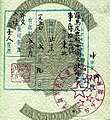 Very early PRC issued Diplomatic visa on a RPR passport from 1950.
Very early PRC issued Diplomatic visa on a RPR passport from 1950.- 1955 (left) and 1951 (right) versions of the PRC passport.
_1987.jpg) A Type "82" passport issued from early 80s to 1992
A Type "82" passport issued from early 80s to 1992- 1992 version of diplomatic passport
 Cover of Type "92" passport, issued until early 2000s
Cover of Type "92" passport, issued until early 2000s Type "97-1" passport, issued from 2000 to early 2007
Type "97-1" passport, issued from 2000 to early 2007 1997 version of diplomatic passport
1997 version of diplomatic passport 1997 version of public affairs passport
1997 version of public affairs passport 1997 version of service passport
1997 version of service passport.jpg) Type "97-2" passport, issued from early 2007 to May 2012
Type "97-2" passport, issued from early 2007 to May 2012 The old passport for public affairs, issued before 2007
The old passport for public affairs, issued before 2007 Current version of biometric passport
Current version of biometric passport
See also
References
- ↑ Article 13 of the Chinese passport law
- ↑ http://timesofindia.indiatimes.com/city/agartala/India-ranks-third-in-issuing-passports/articleshow/50401641.cms India ranks third in issuing passports
- ↑ 3800万中国公民持有普通护照 电子护照正式签发启用
- ↑ 国务院关于出境入境管理法执行情况的报告
- ↑ "Foreign Minister Yang Jiechi Attends the Launch Ceremony for the Trial Issuance of E-Passports for Public Affairs". Ministry of Foreign Affairs. Retrieved 15 February 2011.
- ↑ "因公电子护照31日试点签发 可使持照人快速通关". 中国网. Retrieved 15 February 2011.
- ↑ 中华人民共和国外交部公告 (in Chinese). Ministry of Foreign Affairs of the People's Republic of China. 1 June 2011. Retrieved 31 August 2011.
- ↑ "Chinese passports to get chipped". China Daily USA. Retrieved 5 May 2012.
- 1 2 "4月全国启用新号段电子普通护照 你拿到新护照了吗 - 爱旅行网". www.ailvxing.com. Retrieved 2017-11-19.
- ↑ Full text of Passport Law of the People's Republic of China
- 1 2 Introduction of Chinese passports
- ↑
- 1 2 中国护照遭遇国际尴尬 因公护照将退出历史舞台
- ↑ China Daily, 24 January 1997
- ↑ 2002 National Economic and Social Development Statistics National Bureau of Statistics of the People's Republic of China 28 February 2003
- ↑ China Weighs Passport Reform Beijing Youth Daily 2 April 2002
- ↑ Article 10, Provisional Regulations on the Administration of the Ordinary Passport for Public Affairs
- ↑ 中国公民在海外申办护照、旅行证件须知
- ↑ "上海市出入境管理局电子政务平台". crj.police.sh.cn. Retrieved 2017-11-20.
- ↑ 中国护照管理15日起执行新办法 4种情形可办加急
- ↑ 新疆“统一”中国护照签发政策
- ↑ "细说首都机场边防自助通关". BCIA. November 23, 2012. Retrieved July 2, 2015.
- 1 2 "首都机场自助通关出境 最快6秒-新华网". news.xinhuanet.com. Retrieved 2016-09-06.
- ↑ 网易. "上海启用26条出境边检自助通关通道". news.163.com. Retrieved 2017-12-02.
- ↑ "边检扩大自助通关人员范围 10类旅客从昆明出入境5秒可通关". 昆明信息港. Retrieved 2016-09-06.
- ↑ "Global Ranking - Visa Restriction Index 2018" (PDF). Henley & Partners. Retrieved 31 May 2018.
- ↑ 中国领事服务网. "持普通护照中国公民前往有关国家入境便利待遇一览表(2016年11月22日更新)". Retrieved 2016-06-01.
- ↑
- ↑ Chinese can visit 18 countries without prior visas Global Times 15 November 2013
- ↑ 旅居海外大陸地區人民申請入台觀光須知
- ↑ "Statistical Yearbook - Department of Commerce".
- ↑ Anuário de Estatística do Turismo
- ↑
- ↑ Tourism Statistics for Antigua and Barbuda
- ↑
- ↑ "Archived copy" (PDF). Archived from the original (PDF) on 2017-02-14. Retrieved 2017-05-30.
- ↑ "Number of foreign citizens arrived to Azerbaijan by countries".
- ↑ Stopovers by Country, table 34
- ↑ https://corporate.visitbarbados.org/wp-content/uploads/2017/12/2016-annual-statistical-report.pdf
- ↑ Tourisme selon pays de provenance
- ↑ Abstract of Statistics Archived 2017-05-10 at the Wayback Machine.
- ↑ Annual Reports
- ↑ Estadísticas por Actividad Económica. Turísmo
- ↑ TOURISM STATISTICS Cumulative data, January – December 2017
- ↑ Tourism Statistics Annual Report 2015
- ↑ "Demanda Turstica Internacional Slides 2017" (PDF). Retrieved 2018-06-10.
- ↑ Abstract of Statistics. Chapitre 19 Statistiques du tourismep. 280
- ↑ Tourism Statistics Report
- ↑ "Service bulletin International Travel: Advance Information" (PDF). statcan.gc.ca.
- ↑ Air Visitor Arrivals - Origin & General Evolution Analysis
- ↑
- ↑ The data obtained on request. Ministerio de Comercio, Industria y Turismo de Colombia
- ↑
- ↑ https://www.corporate.southpacificislands.travel/wp-content/uploads/2017/02/2017-AnnualTourist-Arrivals-Review-F.pdf
- ↑
- ↑ Anuario de Turismo
- ↑ TOURIST ARRIVALS AND NIGHTS IN 2017
- ↑
- ↑ ARRIVALS OF TOURISTS BY COUNTRY OF USUAL RESIDENCE
- ↑ - 4. quarter of 2017 - Table 5 Guests, overnight stays (non-residents by country, numbers, indices)
- ↑ 2015 Visitors Statistics Report
- ↑
- ↑
- ↑
- ↑ "Appendix table 5.2. Visitor arrivals and nights spent by country of residence, January-December 2017".
- ↑
- ↑ Nombre de touristas
- ↑ Tourismus in Zahlen 2016, Statistisches Bundesamt
- ↑ International arrivals (2017 year)
- ↑ Hellenic Statistical Authority. Non-residents arrivals from abroad 2015
- ↑ Visitor arrival statistics. Origin of air arrivals
- ↑
- ↑ TOURISM IN HUNGARY 2016
- ↑
- ↑
- ↑
- ↑ TOURIST ARRIVALS TO ISRAEL (EXC. DAY VISITORS & CRUISE PASSENGERS) BY NATIONALITY, Ministry of Tourism
- ↑ IAGGIATORI STRANIERI NUMERO DI VIAGGIATORI
- ↑ Monthly Statistical Report December 2017 Vol xxvii No 12
- ↑ 2017 Foreign Visitors & Japanese Departures, Japan National Tourism Organization
- ↑ Tourist Overnight and Same Day Visitors By Nationality during
- ↑ Туризм Казахстана. 2.4 Количество посетителей по въездному туризму
- ↑ https://www.corporate.southpacificislands.travel/wp-content/uploads/2017/02/2017-AnnualTourist-Arrivals-Review-F.pdf
- ↑ Туризм в Кыргызстане
- ↑
- ↑
- ↑ Arrivals according to nationality during year 2016
- ↑ Number of guests and overnights in Lithuanian accommodation establishments. '000. All markets. 2015-2016
- ↑ "Arrivals by touristic region and country of residence (All types of accommodation) 2011 - 2016". www.statistiques.public.lu.
- ↑ Visitor Arrivals
- ↑
- ↑
- ↑ TOURIST ARRIVALS TO MALAYSIA BY COUNTRY OF NATIONALITY DECEMBER 2017
- ↑ Number of visitors by country, 2009
- ↑ http://www.tourism.gov.mv/packages/december-2017/
- ↑ ANNUAIRE 2014
- ↑ https://www.corporate.southpacificislands.travel/wp-content/uploads/2017/02/2017-AnnualTourist-Arrivals-Review-F.pdf
- ↑
- ↑ Norfi Carrodeguas. "Datatur3 - Visitantes por Nacionalidad".
- ↑ https://www.corporate.southpacificislands.travel/wp-content/uploads/2017/02/2017-AnnualTourist-Arrivals-Review-F.pdf
- ↑ "Archived copy". Archived from the original on 2016-10-01. Retrieved 2016-10-22.
- ↑
- ↑ Table 4. Foreign tourist arrivals and overnight stays by countries, 2014
- ↑
- ↑
- ↑
- ↑ Nepal Tourism Statistics 2015
- ↑ Toerisme in perspectief 2018
- ↑ https://www.corporate.southpacificislands.travel/wp-content/uploads/2017/02/2017-AnnualTourist-Arrivals-Review-F.pdf
- ↑ https://www.corporate.southpacificislands.travel/wp-content/uploads/2017/02/2017-AnnualTourist-Arrivals-Review-F.pdf
- ↑ "International travel and migration: December 2017". Statistics New Zealand. Retrieved 2 February 2018.
- ↑ "Central Statistics Division (CSD) - CNMI Department of Commerce".
- ↑ Number of Tourists to Oman
- ↑ Pakistan Statistical Year Book 2012 20.31
- ↑
- ↑
- ↑
- ↑ The data obtained on request. Ministerio de Comercio Exterior y Turismo Archived 2016-12-02 at the Wayback Machine.
- ↑
- ↑ "in 2016 - tables TABL. III/6. NON-RESIDENTS VISITING POLAND IN 2016 AND THEIR EXPENDITURE" (PDF).
- ↑
- ↑ "Въезд иностранных граждан в РФ". Fedstat.ru. 2017-10-18. Retrieved 2017-10-18.
- ↑ https://www.corporate.southpacificislands.travel/wp-content/uploads/2017/02/2017-AnnualTourist-Arrivals-Review-F.pdf
- ↑
- ↑ Tourist turnover - December 2017
- ↑
- ↑
- ↑
- ↑
- ↑ Visitor Statistics, 2015-2017
- ↑
- ↑ Home > Tourism Statistics > key facts on toursim > Korea, Monthly Statistics of Tourism
- ↑ Entradas de turistas según País de Residencia
- ↑ "TOURIST ARRIVALS BY COUNTRY OF RESIDENCE 2017" (PDF).
- ↑ "Suriname Tourism Statistics" (PDF). www.surinametourism.sr. Retrieved 8 June 2018.
- ↑ Swaziland Tourism Statistics - Arrivals by country
- ↑ Visitor Arrivals by Residence
- ↑ "The 2016 International Visitors' Exit Survey Report. International Tourist Arrivals. p. 73-77" (PDF). nbs.go.tz/. NBS Tanzania. Retrieved 18 December 2017.
- ↑ https://www.corporate.southpacificislands.travel/wp-content/uploads/2017/02/2017-AnnualTourist-Arrivals-Review-F.pdf
- ↑
- ↑ "สถิติด้านการท่องเที่ยว ปี 2560 (Tourism Statistics 2017)". Ministry of Tourism & Sports. Retrieved 16 January 2018.
- ↑ https://www.corporate.southpacificislands.travel/wp-content/uploads/2017/02/2017-AnnualTourist-Arrivals-Review-F.pdf
- ↑
- ↑ NUMBER OF ARRIVING-DEPARTING VISITORS, FOREIGNERS AND CITIZENS December 2017
- ↑ https://www.corporate.southpacificislands.travel/wp-content/uploads/2017/02/2017-AnnualTourist-Arrivals-Review-F.pdf
- ↑ Migration - Visitors by nationalities
- ↑ "Foreign citizens who visited Ukraine in 2017 year, by countries".
- ↑ Statistics for the Emirate of Dubai
Dubai Statistics, Visitor by Nationality - ↑ "Annual estimates on visits and spending in the UK by overseas residents, by purpose and region of visit". Office of National Statistics.
- ↑ Includes the People's Republic of China, Hong Kong, and Macau.
- ↑ Yearbook of Immigration Statistics
- ↑ "Распределение въехавших в Республику Узбекистан иностранных граждан по странам в 2015 году". data.gov.uz. Retrieved 12 March 2018.
- ↑ https://www.corporate.southpacificislands.travel/wp-content/uploads/2017/02/2017-AnnualTourist-Arrivals-Review-F.pdf
- ↑
- ↑ International visitors to Viet Nam in December and 12 months of 2017
- ↑ Tourism Statistical Digests
- ↑ 网易. "即刻起航 东航四架飞机飞赴巴厘岛协助游客回国_网易新闻". bj.news.163.com. Retrieved 2017-11-30.
- ↑ 网易. "台媒关注大陆包机接巴厘岛滞留旅客 台当局则要旅客自助_《参考消息》官方网站(全文)". news.163.com. Retrieved 2017-12-01.
- ↑ "快讯:截至2日18时 国内航空公司共协助13514名滞留巴厘岛游客回国-中国民航网". www.caacnews.com.cn. Retrieved 2017-12-03.
- ↑ "飓风袭加勒比 东航两架政府包机跨越19国接回中方人员". 金融界. 2017-09-30. Retrieved 2017-11-30.
- ↑ 张阳. "尼泊尔地震,中国人又先撤了_国际新闻_环球网". world.huanqiu.com. Retrieved 2017-11-30.
- ↑ "新西兰震后,歪果仁看着天空中被中国承包的救援飞机,懵了……". www.sohu.com. 2016-11-17. Retrieved 2017-12-03.
- ↑ "中国海军也门撤侨细节披露:730炮对准港口随时开火". 2017-05-20. Retrieved 2017-12-01.
- ↑ "利比亚撤侨亲历者讲述:唱国歌举国旗过境 没花1分钱_新闻_腾讯网". news.qq.com (in Chinese). Retrieved 2017-11-30.
- ↑ "China maps path to new conflicts in its passports". The Age. November 23, 2012. Retrieved November 26, 2012.
- ↑ "Here's the Chinese passport map that's infuriating much of Asia". The Washington Post. November 26, 2012. Retrieved November 26, 2012.
- 1 2 No Exit: China Uses Passports as Political Cudgel February 22, 2013 NYT
- ↑ Yamaguchi, Mari (2 February 2016). "Man who spent 3 months in Tokyo airport to leave". Associated Press.
- ↑ http://www.straitstimes.com/asia/east-asia/dna-sample-required-to-get-passport-in-xinjiang
External links
| Wikimedia Commons has media related to Passports of China. |
.svg.png)